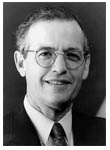|
December 6, 2000: President's Page Geosciences: Breaking New Ground
In the 1960s Princeton's geoscientists conducted trail-blazing research that contributed significantly to the theory of plate tectonics, a unifying idea that explains diverse phenomena such as the complementary shapes of continents, and the preferred locations of earthquakes, volcanoes, and mountain ranges. Today our faculty members and students continue to explore these and related topics, traveling to destinations as diverse as Scotland, New Mexico, the Galapagos Islands, and the Himalayas to conduct field work. Research also takes place at home in laboratories in Guyot Hall where, for example, Professor Thomas Duffy subjects minute samples of materials to conditions similar to those deep within the earth - meaning pressures approaching one million atmospheres and temperatures reaching several thousand degrees Celsius. Increasingly the power of computer technology is being harnessed to answer questions, for example, about motion in the hot interior of our planet. Professor Hans-Peter Bunge is using a cluster of desktop computers (as powerful as a supercomputer, and aptly nicknamed Geowulf) to reconstruct the continual changes the solid earth has experienced over hundreds of millions of years. One of the major goals of geosciences today is not only to determine where the continents were located at different times, and when different mountain belts were formed, but also to explain how those changes contributed to dramatic changes in climate, from swelteringly hot conditions a hundred million years ago when dinosaurs roamed across the continents, to recurrent Ice Ages over the past three million years. These studies, which include Professor Gerta Keller's research on the cretaceous period, and Professor Michael Bender's analyses of air bubbles trapped in the ice of Antarctica up to 400,000 years ago, are of far more than academic interest; they provide critical tests for, and thus bolster confidence in, the models being developed to predict the impact humans are having on the processes that make this a habitable planet. Of particular interest is the fate of the carbon dioxide we inject into the atmosphere by burning fossil fuels. How much of that gas remains in the atmosphere? How much do the oceans and the plants on land absorb? Can we safely sequester the carbon dioxide deep below the earth's surface or on the ocean floor, rather than inject it into the atmosphere? To provide answers, British Petroleum and the Ford Motor Company recently made a significant grant to the University to support the Carbon Mitigation Initiative. Project participants include several geosciences faculty members - Professors Michael Bender, Francois Morel, Satish Myneni, Jorge Sarmiento, Daniel Sigman and Bess Ward - plus colleagues in the Princeton Environmental Institute, the Department of Ecology and Evolutionary Biology, the Department of Civil and Environmental Engineering, the Program in Atmospheric and Oceanic Sciences, and the Geophysical Fluid Dynamics Laboratory, a government agency located at Princeton whose focus is the prediction of weather and climate. Changes in the study of the earth require changes in how geosciences are taught. Members of the department are restructuring course offerings for undergraduates, redesigning traditional introductory courses and creating new ones. For example, a course on the history of our planet gives a new perspective by describing how that history depends on biogeochemical cycles - the continual exchange of matter such as water, carbon and nitrogen between the solid earth, atmosphere, oceans and biosphere. New courses are devoted to the atmospheric and oceanic sciences, and also to policy issues that arise because of our impact on the environment. For example, Professor Gregory Van der Vink's course, "Dealing with Natural Disasters," challenges students to develop economically-realistic as well as scientifically-sound recommendations and asks them to consider policy as well as environmental implications of natural disasters. Changes in geosciences also have a significant impact on facility requirements, and major renovation and expansion of the home of geosciences, Guyot Hall, are slated to begin next year. The expansion includes new space for exhibits from the Guyot Hall natural history museum. The exhibition space will provide an educational experience that pays homage to the past achievements of faculty and introduces visitors to recent cutting-edge work undertaken by members of the department. In short, geosciences
are breaking new ground, and Princeton geoscientists are helping
us understand the powerful forces that influence the planet on which
we live. The answers they provide may determine its continued habitability.
|

 As
part of the 250th Anniversary Celebration, I was honored to be asked
to participate in a conference sponsored by Professor George Philander,
chair of the Department of Geosciences, and his colleagues on "The
Habitability of the Earth." The conference demonstrated the
many ways in which the field of geosciences is providing new insight
into the nature and sustainability of our planet and its environment.
Princeton's Department of Geosciences aims to be at the forefront
of these efforts, building on a tradition of seminal contributions
to solid earth science. As the recent change in the department's
name from Geological and Geophysical Sciences to Geo-sciences suggests,
the earth today is being studied as a system, and advances will
require the integration of previously independent sub-fields, greater
collaboration with other sciences and other disciplines, and the
introduction of new research tools.
As
part of the 250th Anniversary Celebration, I was honored to be asked
to participate in a conference sponsored by Professor George Philander,
chair of the Department of Geosciences, and his colleagues on "The
Habitability of the Earth." The conference demonstrated the
many ways in which the field of geosciences is providing new insight
into the nature and sustainability of our planet and its environment.
Princeton's Department of Geosciences aims to be at the forefront
of these efforts, building on a tradition of seminal contributions
to solid earth science. As the recent change in the department's
name from Geological and Geophysical Sciences to Geo-sciences suggests,
the earth today is being studied as a system, and advances will
require the integration of previously independent sub-fields, greater
collaboration with other sciences and other disciplines, and the
introduction of new research tools.